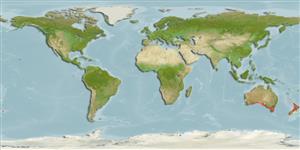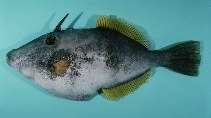Meuschenia scaber (Forster, 1801)
Velvet leatherjacket
إضافة ملاحظاتك Fish Watcher
| Native range | All suitable habitat | Point map | Year 2050 |

|
| This map was computer-generated and has not yet been reviewed. |
| Meuschenia scaber AquaMaps Data sources: GBIF OBIS |
ارفع صور و مقاطع فيديو
Pictures | صور قوقلMeuschenia scaber
Picture by Randall, J.E.
Pictures | صور قوقلMeuschenia scaber
Picture by Randall, J.E.
Common names from other countries
التصنيف / Names الأسماء الشائعة | مرادفات | Catalog of Fishes(جنس, الانواع) | ITIS | CoL | WoRMS | Cloffa
Environment: milieu / climate zone / depth range / distribution range البيئة
بحري القاع; نطاق العمق 20 - 200 m (Ref. 9563). Temperate; 29°S - 47°S, 113°E - 176°W
التوزيع دول | مناطق الفاو | النظام البيئي | الظهور | Point map | مقدمة | Faunafri
Indo-West Pacific: New Zealand and Australia (southern Western Australia to New South Wales and Tasmania).
الحجم / وزن / العمر
Maturity: Lm ? range ? - ? cm
Max length : 31.0 cm TL ذكر/ مختلط الجنس; (Ref. 9563); common length : 25.0 cm TL ذكر/ مختلط الجنس; (Ref. 9258)
Max length : 31.0 cm TL ذكر/ مختلط الجنس; (Ref. 9563); common length : 25.0 cm TL ذكر/ مختلط الجنس; (Ref. 9258)
وصف مختصر مفاتيح التعريف | الوصف الخارجي | قياسات المظهر الخارجي
الأشواك الظهرية (المجموع) : 2; الأشعة الظهرية الناعمة (المجموع) : 32 - 38; أشعه شرجية لينه: 31 - 36. Scales small with numerous tiny spinules, prominent first dorsal spine above eyes (Ref. 9002).
Inhabits rocky weedy areas from the shore to at least 60 m. Generally solitary but may aggregate in groups of 10-15 individuals in midwater. Feeds mainly on sessile and encrusting organisms, with sponges and ascidians predominating (Ref. 26966); also seen feeding mid-water on zooplankton and likes to bite diver's fingers (Ref. 9002).
Life cycle and mating behavior النضج | التكاثر | وضع البيض | بيض | الخصوبة | Larvae
المرجع الرئيسي
Upload your references | مراجع | المنظم : Hutchins, Barry | المتعاونين
Armitage, R.O., D.A. Payne, G.J. Lockley, H.M. Currie, R.L. Colban, B.G. Lamb and L.J. Paul (eds.), 1994. Guide book to New Zealand commercial fish species. Revised edition. New Zealand Fishing Industry Board, Wellington, New Zealand, 216 p. (Ref. 9258)
خطر للأنسان
Harmless
استخدامات بشرية
مصائد: تجاري
FAO(مصائد: الأنتاج; publication : search) | FishSource | البحر حولنا
مزيد من المعلومات
Population dynamics
معاملات النمو
Max. ages / sizes
Length-weight rel.
Length-length rel.
الطول- الترددات
Mass conversion
توظيف
الوفرة
معاملات النمو
Max. ages / sizes
Length-weight rel.
Length-length rel.
الطول- الترددات
Mass conversion
توظيف
الوفرة
Life cycle
التكاثر
النضج
الخصوبة
وضع البيض
Spawning aggregations
بيض
تطور البيضة
Larvae
حركة انتقال اليرقات
التكاثر
النضج
الخصوبة
وضع البيض
Spawning aggregations
بيض
تطور البيضة
Larvae
حركة انتقال اليرقات
Anatomy
منطقة الخياشيم
Brain
Otolith
منطقة الخياشيم
Brain
Otolith
Physiology
Body composition
Nutrients
استهلاك الأوكسجين
نوع السباحة
سرعة السباحة
Visual pigments
Fish sound
Diseases & Parasites
Toxicity (LC50s)
Body composition
Nutrients
استهلاك الأوكسجين
نوع السباحة
سرعة السباحة
Visual pigments
Fish sound
Diseases & Parasites
Toxicity (LC50s)
Human related
Aquaculture systems
ملامح تربية الأحياء المائية
سلالات
Ciguatera cases
Stamps, coins, misc.
Aquaculture systems
ملامح تربية الأحياء المائية
سلالات
Ciguatera cases
Stamps, coins, misc.
أدوات
E-book | دليل الميدان | Length-frequency wizard | أداة تاريخ الحياة | نقطة علي الخريطة | Classification Tree
| Catch-MSY |
تقارير خاصة
البحث عن صيانت الأحواض المائيه | التحقق من وجود صفحات حقائق الأنواع | البحث عنا حقائق حول الأحواض المائيه
Download XML
مصادر علي الأنترنت
Aquatic Commons | BHL | Cloffa | Websites from users | البحث في مراقبي الأسماك | CISTI | Catalog of Fishes(جنس, الانواع) | DiscoverLife | ECOTOX | Faunafri | Fishtrace | GenBank(الوراثة, نيوكلوتيدة) | GloBI | GOBASE | | Google Books | Google Scholar | Google | IGFA World Record | MitoFish | Otolith Atlas of Taiwan Fishes | PubMed | Reef Life Survey | Scirus | SeaLifeBase | شجرة الحياة | Wikipedia(ذهب, بحث) | World Records Freshwater Fishing | سجلات علم الحيوانات
Estimates based on models
Preferred temperature (Ref. 115969): 13.4 - 17.7, mean 15.1 (based on 141 cells).
Phylogenetic diversity index (Ref. 82804): PD50 = 0.5039 [Uniqueness, from 0.5 = low to 2.0 = high].
Bayesian length-weight: a=0.02754 (0.01491 - 0.05088), b=2.97 (2.81 - 3.13), in cm Total Length, based on LWR estimates for this species & (Sub)family-body (Ref. 93245).
مستوى غذائي (Ref. 69278): 3.1 ±0.0 se; based on diet studies.
المرونه (Ref. 120179): وسيط, الحد الزمني الأدني لتضاعف عدد أفراد المجتمع 1.4-4.4 سنة (Assuming tm=2).
Fishing Vulnerability (Ref. 59153): Low to moderate vulnerability (27 of 100).
Climate Vulnerability (Ref. 125649): Moderate to high vulnerability (49 of 100).




